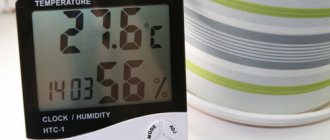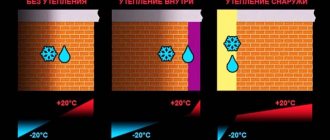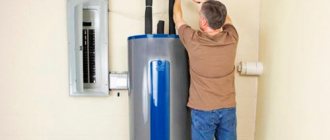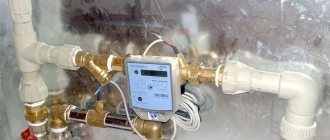Where does moisture come from?
To begin with, you need to determine the following - moisture penetrates into the room from the outside, or is formed directly inside the home.
This will help to determine the cause of its occurrence much faster and more accurately.
Those who have already encountered this problem suggest using a simple verification method:
- Choose a room with the highest level of humidity in your opinion, and in which there is a wall facing outside. Typically these are end rooms;
- Take a small piece of ordinary glass, attach it to the selected wall and secure it. Depending on the finishing material, this can be done using masking tape or push pins;
- It is necessary to attach the glass to a flat section of the wall to ensure maximum adhesion;
- After a few hours, unfasten the glass and inspect it;
- If its surface has become wet on the side adjacent to the wall, it means that dampness is entering the apartment from the street. If moisture was found on the other side, it means that something inside the apartment is causing its excess.
Preventing the appearance of dampness
Following certain rules will help reduce dampness to a minimum and prevent its occurrence in the future.
- Laundry should be dried outside living rooms or with the hood turned on for air removal.
- When cooking, pots and pans should be covered with lids to prevent steam from escaping.
- In the bathroom, where the highest concentration of humidity is, as well as in the kitchen, hoods and ventilation openings should be regularly cleaned to remove excess debris, and these rooms should also be ventilated daily.
- In a private house, you can insulate the attic and also cover the walls with a waterproofing material, preferably with pores.
- All flammable substances that form a lot of moisture, in particular paraffin, should be used extremely rarely indoors.
- All rooms in the house should be ventilated daily.
- Correct errors in the heating system in a timely manner.
- Use a dehumidifier to reduce humidity. This household appliance can easily cope with the problem of dampness, and its compactness allows you to move the dehumidifier from room to room.
The effect of dampness on housing and people
In case of untimely actions aimed at eliminating dampness, or in case of ignoring the problem, unpleasant consequences will certainly arise.
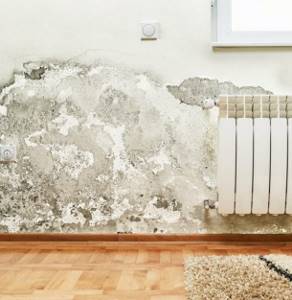
- A persistent heavy smell characteristic of basements will appear in the apartment
- Finishing materials, namely wallpaper or plaster, will begin to peel off. The putty saturated with moisture becomes loose and moves away from the surface of the wall or ceiling in whole layers;
- Wooden floors or floor coverings may become deformed, cracks will form at the joints of elements, and a characteristic creaking will appear;
- Furniture items made from natural materials will also be subject to deformation;
- In the case when the humidity level exceeds normal levels for humans of 40-60%, this leads to aggravation respiratory diseases or their development;
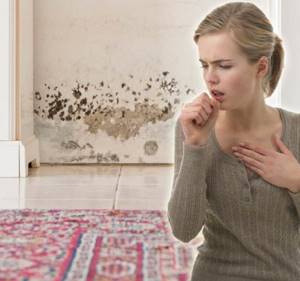
- Allergies may worsen;
- All microbes and bacteria develop much faster and more actively in a humid environment;
- Skin rashes will appear, wounds or scratches will take longer to heal or rot;
- Such a microclimate is especially dangerous for young children, whose immunity has not yet strengthened and cannot provide adequate resistance. Children are easily susceptible to illness and stay sick longer;
- A clear consequence will be education on the walls or ceiling of black fungus, that is mold.

Reasons for damp penetration from the street
In most cases, the cause of high levels of humidity in an apartment is the developer’s mistakes.
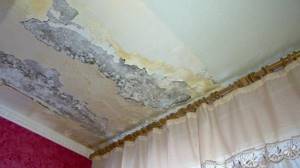
- Leaky joints between elements of a panel structure or brickwork. Very often in old houses the mortar on which the bricks are held simply spills out. Thus, the integrity of the walls is violated, and voids are formed into which dampness penetrates;
- If we are talking about apartments on the ground floors, dampness can penetrate from a flooded basement through leaky joints between the floor and walls;
- Flooding of basements during precipitation or melting snow also leads to destruction of the blind area of the house;
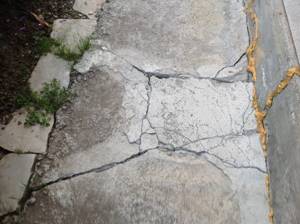
- A common problem with apartments on the top floors is roof leakage, as a result of which during rainfall the attic space is flooded if the roof has a hipped structure, or directly in the flow of the ceiling in the home. This reason can be difficult to identify if the ceilings in the room are suspended. Water will not be able to seep through the canvas due to the characteristics of the material, but will evaporate in the space between the floor slab and the canvas and penetrate into the room through the mounting holes for lamps or the gaps between the wall and the mounting profile;
- If the ventilation system in the house was thought out or implemented incorrectly, it will not be able to ensure the timely outflow of warm air in full, which will lead to an increase in humidity.
The corners on the upper floors of the building are damp
In private houses or on the highest floors, the walls are often damp due to the attic.
This happens in the following cases:
- the corners turn gray due to violations in the insulation of the attic; dampness and black spots appear most of all in places where the attic floor adjoins the external walls;
- the attic space is poorly ventilated (few ventilation holes, no through ventilation); with good ventilation in the attic, the same temperature is maintained over the entire surface of the roof in the autumn-winter season.
Solutions to the problem
The above defects, especially those related to the destruction of the blind area of the house, flooding of the basement due to leaky old sewer pipes or leaking roofs, should be resolved by the management organization or housing and communal services on whose balance sheet your house is located.

Be sure to submit a request with a detailed description of the problem. If such actions are unsuccessful or take too long, follow these steps:
- If the reason is a flooded basement , waterproof the floor and seal it around the perimeter;
- If the reason is violation of the integrity of the walls outside, contact the appropriate organizations that carry out work on waterproofing walls. It is best to combine this with external insulation. If the apartment is on the ground floor, you can finish the exterior walls with waterproofing mortar and then cover it with foam sheets yourself;

to correct the design of the ventilation system in an apartment building. In this case, installing a supply and exhaust valve will help. This system is also called an alpine window. The design of the valve and the principle of its operation are quite simple, and installation can be done independently.

It is recommended to install an alpine window in every room. Usually the valve is placed above the window opening so that fresh air from the street in the cold season, penetrating into the home, mixes with warm air rising upward from the heating radiators and does not cool the room.
Reducing humidity
If walls often get wet in interior rooms with high moisture (bathhouse, bathroom), then the problem is most likely in the ventilation system. Therefore, first of all, you should check the ventilation openings for the presence of unnecessary objects that may interfere with air circulation.
It’s easy to check how clogged the ventilation channels are: hold a burning candle to the vent and watch how the flame reacts: if it reaches towards the grate, then the channels are not clogged and there is a draft. When there is no flame response to ventilation, additional devices need to be installed in order to establish air circulation.
When the holes are not clogged, but the draft is still weak, additional slots can be made at the bottom of the door for air intake. If this does not help, a forced exhaust is installed in the ventilation duct. Such fans are turned on only when there are no people in the room, as they can seriously harm your health.
Experts advise installing fans with a built-in humidity controller in the bathroom. When humidity rises, the fan operates automatically, eliminating air oversaturated with dampness.
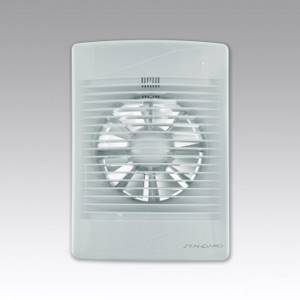
Sources of excess moisture inside the home
If, after conducting an experiment with glass, you are convinced that the reason for the appearance of dampness lies inside the apartment, you need to make a thorough inspection of it and analyze your own habits and actions.

- Those who do not have balconies, or those who simply do not have enough space, often have to dry their laundry by hanging it throughout the apartment. If this is done on an ongoing basis, you need to reconsider your habits;
- The presence of aquariums in an apartment can cause increased humidity, especially if they are not equipped with special covers;
- Excessive number of indoor flowers;
- The reason may be irregular ventilation or its complete absence;
- Clogged ventilation ducts;
- Blocking of ventilation due to improper installation of household appliances or its blocking with finishing materials;
- Violation of the integrity of water pipes, which leads to regular leakage of water. If the pipes are hidden in plasterboard boxes, it will be impossible to notice the leak. Go to your downstairs neighbors and inspect their ceiling to rule out this cause;
- Carefully inspect the ceiling in your apartment, especially in the bathroom. Perhaps it is not you who have a leak, but the neighbors above you;
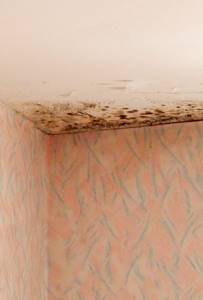
- Incorrect installation of plumbing elements;
- Leaks in plastic window structures;
- Cold slopes.
Solutions to the problem
All of the above reasons can be easily eliminated on your own. However, if already at the initial stages of inspecting the apartment you managed to find the source, it is worth completing the inspection to the end.
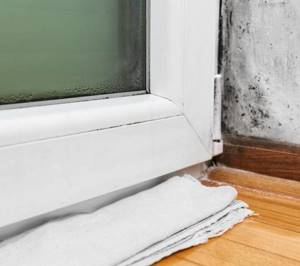
Often a combination of several factors simultaneously contributes to the formation of dampness.
- It may be worth dividing the laundry into parts and washing in several stages, or washing more often, but with fewer items. If finances allow, a washing machine with a drying function will be a real salvation;
- Moisture-loving indoor plants require frequent watering and spraying. If you have just such plants, you will have to either reduce their number or dilute them with plants that, on the contrary, are capable of absorbing moisture from the air;
- In old houses, the ventilation often becomes clogged, debris sticks to its walls, which gradually leads to a narrowing and then to complete overgrowing of the duct. Checking if you draft is very simple - hold a match to the vent, light it, and then blow it out. If the smoke is immediately drawn into the channel, then everything is in order. Otherwise, you should try to clean the hole yourself and repeat the test. If nothing has changed, contact the housing and communal services department for help;
- Carefully inspect the pipes in the bathroom and under the sink: if a leak is detected, immediately replace the leaking section of the system;
- Check how tightly the walls of the bathtub or shower stall fit against the walls. Perhaps water regularly flows behind the bathtub or tray and accumulates there, forming dampness. It is necessary to thoroughly dry the wall and floor and inspect them for mold. If fungus has already formed, use special purchased compounds to destroy it, and then fill the cracks with sealant;
- If condensation constantly forms on the window sill or on the glass unit, it is necessary to inspect the window structure. Pay attention to the rubber seal on the inside of the frame. Press it with your finger. It should instantly return to its original state. If the rubber is hard to the touch, there are small cracks on it and the material has begun to crumble in places, the seal needs to be replaced. If the material still returns to its original state, but not very quickly, it needs to be lubricated with silicone to give it elasticity. Sometimes the design of the window itself and the materials used to make it are of poor quality and only a complete replacement can help;
- If during repairs the window slopes were not insulated enough, they will serve as a source of cold, which will lead to the formation of condensation in the winter. In this case, you will have to perform the insulation again.
General Tips
Both in the case when external causes contributed to the formation of dampness, and in the presence of internal sources, general advice that will help quickly dry the home and return the microclimate to normal levels.
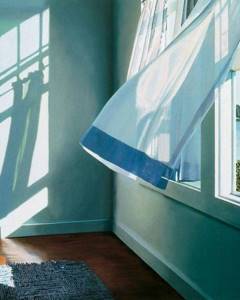
- In the bathroom, install additional forced ventilation and turn it on every time during and after taking a shower or bath and when drying clothes;
- At least for several hours after taking a shower, leave the bathroom door open;
- In a kitchen where there are elevated temperatures and high humidity, be sure to install a hood and turn on the appliance even when you are just boiling the kettle;
- Ventilate the premises more often. Modern fittings for plastic windows have a useful function – micro-ventilation. It allows you to comfortably ventilate your home even in the cold season;
- In summer, try not to shade window openings, but rather open the curtains and let sunlight into the house;
- In spring and autumn, when the heating system is inactive, warm up your home using additional heating devices. It is during this period that the humidity level rises to its maximum. You can use electric fireplaces, oil or infrared heaters, and heat fans. It is better to purchase one small device, but for each room separately. An additional electric heated towel rail can be installed in the bathroom. Some people recommend using heat guns, but remember that they can significantly increase the temperature of the room and heat up everything in it;
- Simple ingredients such as table salt or sugar will help absorb excess moisture. Place containers with this filler in inconspicuous places as an aid. Or use silica gel;
- After wet cleaning, wipe all surfaces dry;
- If the apartment has old wooden windows, be sure to seal them with special paper for the winter and insulate the cracks with foam rubber. This will not only keep the heat inside the home, but also prevent the penetration of moisture from the outside;
- Buy a device called a dehumidifier from a hardware store. It will help quickly remove excess moisture from the air. Some dehumidifier models are equipped with a built-in hygrometer - a device for measuring air humidity levels. This is very convenient, because you can clearly see that the dehumidifier is really working effectively. And in order not to turn the device on/off every now and then, but to easily maintain a constant level of humidity in the apartment, it is better to purchase automatic models;
- Instead of a dehumidifier, you can use a regular air conditioner, which has a dry mode.
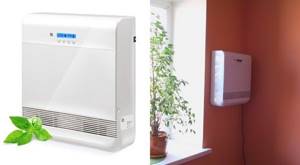
Prevention measures
Preventative measures to prevent high humidity in the house include the following:
- Carrying out waterproofing work to prevent moisture from entering rooms - eliminating leaks, ensuring the tightness of windows, sealing floors, insulating walls, etc.
- Cooking food must be covered. This will prevent the formation of steam and, as a result, an increase in humidity.
- The premises should not be used for other purposes.
- It is necessary to regulate the permissible number of water containers in one room.
- Installing a hood in the kitchen will reduce moisture levels in the air.
- Checking the functionality of the ventilation system and repairing it, if necessary.
- If the room is damp, it is not advisable to place aquariums in it.
- Choosing reliable plastic windows is one way to prevent excess humidity.
- It is best to move drying clothes outside or to the balcony, avoiding hanging wet things indoors.
What to do with raw things?
In damp apartments, as a rule, all things in closets and chests of drawers, sofa covers and bed linen are also damp. The bed feels cold and to the touch . In addition, a characteristic unpleasant odor appears. To get rid of it, you will have to wash all things with the addition of vinegar, dry them thoroughly, and then iron them with steam. You can put linen bags with salt or silica gel in cabinets and chests of drawers. But such actions will be effective only if the causes of dampness in the home have been eliminated and the microclimate has been normalized.
The article was written for the site.
Tags:Cleaning
How to get rid of dampness in a private home: the best methods of combating
Humidity and dampness in the house can appear not only due to unsanitary conditions. A common factor is the incorrect covering of the ceiling and roof, that is, it comes from the outside. Dampness practically poisons people's lives.
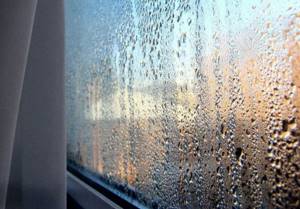
It can cause chronic diseases in residents associated with the respiratory system, skin diseases, etc. Excessive dampness can become a prerequisite for the formation of mold and mildew on the walls, floors, and wallpaper. How to quickly get rid of dampness in a house is a question that many residents ask themselves, but before you start fighting condensation, it is important to understand where the “legs come from.”

